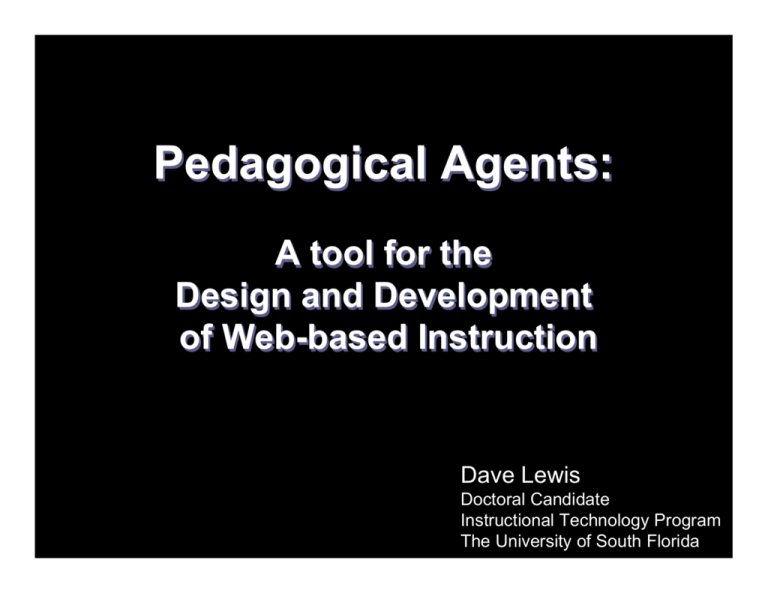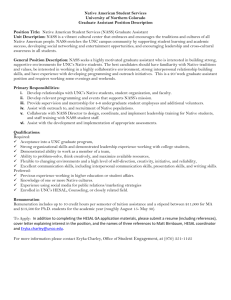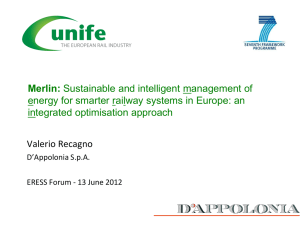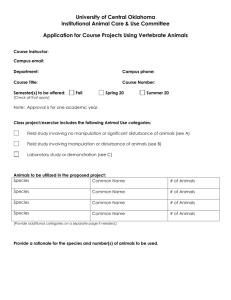Pedagogical Agents
advertisement

Pedagogical Agents: A tool for the Design and Development of Web -based Instruction Web-based Dave Lewis Doctoral Candidate Instructional Technology Program The University of South Florida Presentation History Agent Characteristics Technology Research Where is the Research being done? Web Examples Agent Oliver Selfridge Oliver Selfridge 1958 - Coined the Term “Intelligent Agent” Pandemonium Computer Architecture composed of agents Parallel processing Interface Agent (Maes, 1994) Pattie Maes M.I.T. s Application an d im ita te s Interacts with O bs er ve “…computer programs that employ AI techniques to provide active assistance to a user with computerbased tasks.” Communicate Interacts with User Agent Characteristics Agent Characteristics Embodiment Trainable Mobile Autonomy Intelligence Franklin, S., and Graesser, A. (1997). Is it an Agent, or Just a Program?: A Taxonomy for Autonomous Agents Embodiment Embodied Virtual Physical Disembodied Trainable Can be trained in just like humans Agents build up a memory of user actions try to predict actions of users Situations are analyzed may offer a suggestion or may act Henry Lieberman M.I.T. Training Examples Henry Lieberman M.I.T. Mobility Agents can move across network Execute on host machines Examples Virus (malicious) Search Engine Bots Mobility (i.e. HyperCampus ) Library Service A Customer - Katashi Nagao Service B Gymnasium University Center Service C GPS Infrared receiver Personal database Customer host Intelligence? Perceived Intelligence or True Intelligence Katherine Isbister Perceived Intelligence Autonomy Environment Objects Agents Autonomous Agents (Luck & d'Inverno, 1995) Autonomy - example Google News Fictional Character Autonomy: Multi-agent Systems Thomas Rist German Research Cente for Artificial Intelligence Types of Agent-Based Presentations Non-interactive presentation Non-interactive group presentation Interactive presentation Interactive group presentation System User (Rist, 2002) Types of Agent-Based Interactions System text User text TTS TTS text Voice Commands TTS text voice AutoTutor www.autotutor.org Tutor Simulation simulates the discourse patterns and pedagogical strategies of a typical human tutor delivers a dialogue move, the student types a response Tutors Introductory computer literacy Physics AutoTutor Six major components 1. curriculum scripts 2. language extraction modules 3. latent semantic analysis (LSA) 4. topic selection rules 5. dialogue move generation rules 6. and the embodied agent www.autotutor.org Technology Microsoft Agent Microsoft Bob Microsoft Agent Agent Framework Three components Visual - Animation Verbal – Text-to-speech (TTS) Programming - VBScript Animation - Digital Actors Microsoft Agent Character Editor Synthetic Speech Text-to-Speech (TTS) Dr Stephen Hawking DecTALK - 1983 How may I help you? – AT&T Programming VBScript JavaScript <OBJECT ID="AgentControl" width=0 height=0 CLASSID="CLSID:D45FD31B-5C6E-11D1-9EC1-00C04FD7081F" CODEBASE="#VERSION=2,0,0,0"> </OBJECT> <OBJECT ID="TruVoice" width=0 height=0 CLASSID="CLSID:B8F2846E-CE36-11D0-AC83-00C04FD97575" CODEBASE="#VERSION=6,0,0,0"> </OBJECT> <SCRIPT language=VBScript> Sub Window_OnLoad() AgentControl.Characters.Load "Merlin", “C:\WINDOWS\MSAGENT\chars\merlin.acs" Set Merlin = AgentControl.Characters("Merlin") Merlin.LanguageID = &H409 Merlin.Show Merlin.Speak "Hello and Welcome to the University of South Florida!" Merlin.hide End Sub </SCRIPT> MASH The Microsoft Agent Scripting Helper http://www.bellcraft.com Research Richard Mayer University of California, Santa Barbara The Modality Principle Dual Coding Theory Auditory Visual Multimedia Learning Anthropomorphism debate? Ben Shneiderman University of Maryland 1983 - “Direct manipulation” Clifford Nass Stanford University 1993 - Social Responses to Communication Technology Direct manipulation vs. Manipulation management Ben Shneiderman Alan Kay Coined the term - 1983- “Direct manipulation” Alan Kay - “Manipulation management” of the interface (Kay, 1990) Sketchpad: The First Interactive Computer Graphics Ivan Sutherland – M.I.T. - Ph.D. Dissertation, 1963 Direct Manipulation Ben Shneiderman Manipulation Management Alan Kay Computer Automates some process Xerox Star - 1981 Alan Kay Social Responses to Communication Technology Clifford Nass “Computers Are Social Actors” Paradigm Humans react to computers as if they were human Clifford Nass human brains are “tricked” by 21st century technologies into reacted as if they were human Ethopoeia "Which characteristics of computers encourage which individuals to use which social rules when using a technology?" Clifford Nass Gender and Computers? 2x2x2x2 N=40 Youngme Moon Subject Gender x Tutor voice: Male/Female x Evaluator Voice: Male/Female x Topic: Computers, Love and relationships people tend to treat computers differently, depending on the gender of their synthetic “voices.” Gender and Computers? “women know more about subjects that are typically regarded as ‘feminine’” i.e. Love and relationships “men know more about subjects that are typically regarded as masculine” (Nass et al., 1997) i.e. Computers Gender and Computers? “We are not supporting gender stereotyping but we are identifying something that people designing products should be sensitive about…” Clifford Nass Where is this work being done? Henry Lieberman M.I.T. Clifford Nass Stanford University James Lester North Carolina State University Herman-the-bug Amy Baylor Florida State University MIMIC (Multiple Intelligent Mentors Instructing Collaboratively) Lewis Johnson University of Southern California Lewis Johnson Steve (Soar Training Expert for Virtual Environments) John Bransford Nancy Vye Vanderbilt Summary : Pedagogical Agents are a tool for Instructional Designers and Developers provide the user with automated active assistance Interface agents can use voice and animation Promote Transfer Humans treat computers (agents) as if they were human References Franklin, S., and Graesser, A. (1997). Is it an Agent, or Just a Program?: A Taxonomy for Autonomous Agents. In: J. P. Muller, M. J. Wooldridge, and N. R. Jennings (eds.): Proceedings of the ECAI'96 Workshop on Agent Theories, Architectures, and Languages: Intelligent Agents III, Vol. 1193 of LNAI. Berlin, pp. 21-36. http://csrg.cs.memphis.edu/csrg/assets/papers/is%20it%20an%20Agent,%20or%20just%20a%20 Program%20-%20A%20Taxonomy.htm Kay, A. (1990) User interface: A personal view. In Laurel (Ed) The Art of HumanComputer Interaction, Addison-Wesley, Reading, Ma, pp 191-207 Luck M. & D'Inverno M. P. (1995) A Formal Framework for Agency and Autonomy. Proc.First International Conference on Multi-Agents Systems, San Francisco, CA, p. 254-260. Maes, P. (1994). Agents that reduce work and information overload retrieved Oct 27, 2002 from http://pattie.www.media.mit.edu/people/pattie/CACM-94/CACM94.p1.html Merriam-Webster, Incorporated (2001). Merriam-Webster's Collegiate Dictionary. 10th Ed. Springfield, Mass.: Merriam-Webster, Incorporated. Nass, C (2002) How Human is Human-Computer Interaction? Retrieved Oct 27, 2002 from http://murl.microsoft.com/videos/stanford/CS547/991029_OnDemand_100_100K_3 20x240.htm Ben Shneiderman. Direct manipulation: A step beyond programming languages. IEEE Computer, 16(8):57-69, August 1983. Rist, T. (2002). An Evolutionary Perspective on Animated Presentation Agents and their Application Fields retreived 2-11-02 from http://www.miv.t.u-tokyo.ac.jp/pricai02LAA/rist-abstract.htm Web Sites Our Site: Http://www.coedu.usf.edu/agents/ Other sites Nass http://murl.microsoft.com/videos/stanford/CS547/9910 29_OnDemand_100_100K_320x240.htm M.I.T. Agent Group http://agents.media.mit.edu/index.html Agents that Reduce Work and Information Overload Pattie Maes Is it an Agent, or just a Program?: A Taxonomy for Autonomous Agents - Franklin and Graesser






